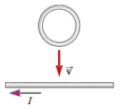
Bundle: Physics for Scientists and Engineers with Modern Physics, Loose-leaf Version, 10th + WebAssign Printed Access Card for Serway/Jewett's Physics for Scientists and Engineers, 10th, Multi-Term
10th Edition
ISBN: 9781337888592
Author: Raymond A. Serway, John W. Jewett
Publisher: Cengage Learning
expand_more
expand_more
format_list_bulleted
Textbook Question
Chapter 30.3, Problem 30.3QQ
Figure 30.12

Figure 30.12 shows a circular loop of wire falling toward a wire carrying a current to the left. What is the direction of the induced current in the loop of wire? (a) clockwise (b) counterclockwise (c) zero (d) impossible to determine
Expert Solution & Answer
Trending nowThis is a popular solution!

Students have asked these similar questions
m
C
A block of mass m slides down a ramp of height hand
collides with an identical block that is initially at rest.
The two blocks stick together and travel around a loop of
radius R without losing contact with the track. Point A is
at the top of the loop, point B is at the end of a horizon-
tal diameter, and point C is at the bottom of the loop, as
shown in the figure above. Assume that friction between
the track and blocks is negligible.
(a) The dots below represent the two connected
blocks at points A, B, and C. Draw free-body dia-
grams showing and labeling the forces (not com
ponents) exerted on the blocks at each position.
Draw the relative lengths of all vectors to reflect
the relative magnitude of the forces.
Point A
Point B
Point C
(b) For each of the following, derive an expression in
terms of m, h, R, and fundamental constants.
i. The speed of moving block at the bottom of
the ramp, just before it contacts the stationary
block
ii. The speed of the two blocks immediately…
The velocity of an elevator is given by the graph shown.
Assume the positive direction is upward.
Velocity (m/s)
3.0
2.5
2.0
1.5
1.0
0.5
0
0
5.0
10
15
20
25
Time (s)
(a) Briefly describe the motion of the elevator.
Justify your description with reference to the
graph.
(b) Assume the elevator starts from an initial position
of y = 0 at t=0. Deriving any numerical values
you
need from the graph:
i. Write an equation for the position as a
function of time for the elevator from
t=0 to t = 3.0 seconds.
ii. Write an equation for the position as a
function of time for the elevator from t = 3.0
seconds to t = 19 seconds.
(c) A student of weight mg gets on the elevator
and rides the elevator during the time interval
shown in the graph. Consider the force of con-
tact, F, between the floor and the student. How
Justify your answer with reference to the graph
does F compare to mg at the following times?
and your equations above.
i. = 1.0 s
ii. = 10.0 s
Students are asked to use circular motion to measure the
coefficient of static friction between two materials. They
have a round turntable with a surface made from one of
the materials, for which they can vary the speed of rotation.
They also have a small block of mass m made from the sec-
ond material. A rough sketch of the apparatus is shown in
the figure below. Additionally they have equipment normally
found in a physics classroom.
Axis
m
(a) Briefly describe a procedure that would allow you
to use this apparatus to calculate the coefficient of
static friction, u.
(b) Based on your procedure, determine how to
analyze the data collected to calculate the
coefficient of friction.
(c) One group of students collects the following
data.
r (m)
fm (rev/s)
0.050
1.30
0.10
0.88
0.15
0.74
0.20
0.61
0.25
0.58
i. Use the empty spaces in the table as needed to
calculate quantities that would allow you to
use the slope of a line graph to calculate the
coefficient of friction, providing labels with…
Chapter 30 Solutions
Bundle: Physics for Scientists and Engineers with Modern Physics, Loose-leaf Version, 10th + WebAssign Printed Access Card for Serway/Jewett's Physics for Scientists and Engineers, 10th, Multi-Term
Ch. 30.1 - A circular loop of wire is held in a uniform...Ch. 30.2 - In Figure 30.8a, a given applied force of...Ch. 30.3 - Figure 30.12 Figure 30.12 shows a circular loop of...Ch. 30.5 - Prob. 30.4QQCh. 30 - A circular loop of wire of radius 12.0 cm is...Ch. 30 - An instrument based on induced emf has been used...Ch. 30 - Scientific work is currently under way to...Ch. 30 - A long solenoid has n = 400 turns per meter and...Ch. 30 - An aluminum ring of radius r1 = 5.00 cm and...Ch. 30 - An aluminum ring of radius r1 and resistance R is...
Ch. 30 - A coil formed by wrapping 50 turns of wire in the...Ch. 30 - When a wire carries an AC current with a known...Ch. 30 - A toroid having a rectangular cross section (a =...Ch. 30 - A small airplane with a wingspan of 14.0 m is...Ch. 30 - A helicopter (Fig. P30.11) has blades of length...Ch. 30 - A 2.00-m length of wire is held in an eastwest...Ch. 30 - A metal rod of mass m slides without friction...Ch. 30 - Prob. 14PCh. 30 - Prob. 15PCh. 30 - An astronaut is connected to her spacecraft by a...Ch. 30 - You are working for a company that manufactures...Ch. 30 - You are working in a laboratory that uses motional...Ch. 30 - You are working in a factory that produces long...Ch. 30 - You are working in a factory that produces long...Ch. 30 - Within the green dashed circle show in Figure...Ch. 30 - Prob. 22PCh. 30 - Prob. 23PCh. 30 - Figure P30.24 (page 820) is a graph of the induced...Ch. 30 - The rotating loop in an AC generator is a square...Ch. 30 - In Figure P30.26, a semicircular conductor of...Ch. 30 - Prob. 27PCh. 30 - Suppose you wrap wire onto the core from a roll of...Ch. 30 - A rectangular loop of area A = 0.160 m2 is placed...Ch. 30 - A rectangular loop of area A is placed in a region...Ch. 30 - A circular coil enclosing an area of 100 cm2 is...Ch. 30 - Consider the apparatus shown in Figure P30.32: a...Ch. 30 - A guitars steel string vibrates (see Fig. 30.5)....Ch. 30 - Why is the following situation impossible? A...Ch. 30 - A conducting rod of length = 35.0 cm is free to...Ch. 30 - Magnetic field values are often determined by...Ch. 30 - The plane of a square loop of wire with edge...Ch. 30 - In Figure P30.38, the rolling axle, 1.50 m long,...Ch. 30 - Figure P30.39 shows a stationary conductor whose...Ch. 30 - Prob. 40APCh. 30 - Figure P30.41 shows a compact, circular coil with...Ch. 30 - Review. In Figure P30.42, a uniform magnetic field...Ch. 30 - An N-turn square coil with side and resistance R...Ch. 30 - A conducting rod of length moves with velocity v...Ch. 30 - A long, straight wire carries a current given by I...Ch. 30 - A rectangular loop of dimensions and w moves with...Ch. 30 - A thin wire = 30.0 cm long is held parallel to...Ch. 30 - An induction furnace uses electromagnetic...Ch. 30 - Prob. 49CPCh. 30 - A betatron is a device that accelerates electrons...Ch. 30 - Review. The bar of mass m in Figure P30.51 is...
Knowledge Booster
Learn more about
Need a deep-dive on the concept behind this application? Look no further. Learn more about this topic, physics and related others by exploring similar questions and additional content below.Similar questions
- In general it is best to conceptualize vectors as arrows in space, and then to make calculations with them using their components. (You must first specify a coordinate system in order to find the components of each arrow.) This problem gives you some practice with the components. Let vectors A = (1,0, -3), B = (-2, 5, 1), and C = (3,1,1). Calculate the following, and express your answers as ordered triplets of values separated by commas.arrow_forwardIn general it is best to conceptualize vectors as arrows in space, and then to make calculations with them using their components. (You must first specify a coordinate system in order to find the components of each arrow.) This problem gives you some practice with the components. Let vectors A = (1,0, −3), B = (-2, 5, 1), and C = (3,1,1). Calculate the following, and express your answers as ordered triplets of values separated by commas.arrow_forwardOnly Part C.) is necessaryarrow_forward
- Only Part B.) is necessaryarrow_forwardA (3.60 m) 30.0°- 70.0° x B (2.40 m)arrow_forwardIn general it is best to conceptualize vectors as arrows in space, and then to make calculations with them using their components. (You must first specify a coordinate system in order to find the components of each arrow.) This problem gives you some practice with the components. Let vectors A = (1,0, -3), B = (-2, 5, 1), and C = (3,1,1). Calculate the following, and express your answers as ordered triplets of values separated by commas.arrow_forward
- fine the magnitude of the vector product express in sq meters what direction is the vector product in -z or +zarrow_forward4) Three point charges of magnitude Q1 = +2.0 μC, Q2 = +3.0 μС, Q3 = = +4.0 μС are located at the corners of a triangle as shown in the figure below. Assume d = 20 cm. (a) Find the resultant force vector acting on Q3. (b) Find the magnitude and direction of the force. d Q3 60° d Q1 60° 60° Q2 darrow_forwardThree point charges of magnitudes Q₁ = +6.0 μС, Q₂ = −7.0 μС, Qз = −13.0 μC are placed on the x-axis at x = 0 cm, x = 40 cm, and x = 120 cm, respectively. What is the force on the Q3 due to the other two charges?arrow_forward
arrow_back_ios
SEE MORE QUESTIONS
arrow_forward_ios
Recommended textbooks for you
 College PhysicsPhysicsISBN:9781285737027Author:Raymond A. Serway, Chris VuillePublisher:Cengage Learning
College PhysicsPhysicsISBN:9781285737027Author:Raymond A. Serway, Chris VuillePublisher:Cengage Learning Physics for Scientists and EngineersPhysicsISBN:9781337553278Author:Raymond A. Serway, John W. JewettPublisher:Cengage Learning
Physics for Scientists and EngineersPhysicsISBN:9781337553278Author:Raymond A. Serway, John W. JewettPublisher:Cengage Learning Physics for Scientists and Engineers with Modern ...PhysicsISBN:9781337553292Author:Raymond A. Serway, John W. JewettPublisher:Cengage Learning
Physics for Scientists and Engineers with Modern ...PhysicsISBN:9781337553292Author:Raymond A. Serway, John W. JewettPublisher:Cengage Learning College PhysicsPhysicsISBN:9781305952300Author:Raymond A. Serway, Chris VuillePublisher:Cengage Learning
College PhysicsPhysicsISBN:9781305952300Author:Raymond A. Serway, Chris VuillePublisher:Cengage Learning Physics for Scientists and Engineers, Technology ...PhysicsISBN:9781305116399Author:Raymond A. Serway, John W. JewettPublisher:Cengage Learning
Physics for Scientists and Engineers, Technology ...PhysicsISBN:9781305116399Author:Raymond A. Serway, John W. JewettPublisher:Cengage Learning Physics for Scientists and Engineers: Foundations...PhysicsISBN:9781133939146Author:Katz, Debora M.Publisher:Cengage Learning
Physics for Scientists and Engineers: Foundations...PhysicsISBN:9781133939146Author:Katz, Debora M.Publisher:Cengage Learning

College Physics
Physics
ISBN:9781285737027
Author:Raymond A. Serway, Chris Vuille
Publisher:Cengage Learning

Physics for Scientists and Engineers
Physics
ISBN:9781337553278
Author:Raymond A. Serway, John W. Jewett
Publisher:Cengage Learning

Physics for Scientists and Engineers with Modern ...
Physics
ISBN:9781337553292
Author:Raymond A. Serway, John W. Jewett
Publisher:Cengage Learning

College Physics
Physics
ISBN:9781305952300
Author:Raymond A. Serway, Chris Vuille
Publisher:Cengage Learning

Physics for Scientists and Engineers, Technology ...
Physics
ISBN:9781305116399
Author:Raymond A. Serway, John W. Jewett
Publisher:Cengage Learning

Physics for Scientists and Engineers: Foundations...
Physics
ISBN:9781133939146
Author:Katz, Debora M.
Publisher:Cengage Learning
What Are Electromagnetic Wave Properties? | Physics in Motion; Author: GPB Education;https://www.youtube.com/watch?v=ftyxZBxBexI;License: Standard YouTube License, CC-BY